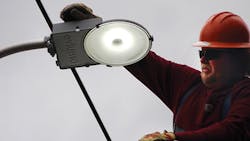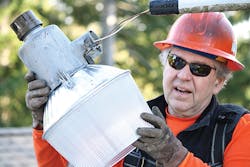Keeping up with the maintenance of outdoor high-pressure sodium (HPS) light fixtures has required a lot of effort since they were first installed in the early 1980s. Like most rural utilities, Mason County Public Utility District No. 3 (PUD 3), based in small-town Shelton, Washington, U.S., provides area security lights to customers on request for a low flat daily rate. PUD 3 supplies the energy, fixture and installation, and maintains the lights, sending a serviceman and a bucket truck to respond to any failures in the field.
A lot can go wrong with HPS fixtures. The bulb can fail, as can the ballast, and the photocell can stop working. Based on experience, the PUD figures as long as an old HPS fixture is in place, something within the unit is likely to fail every five years or less, causing them to send a truck to fix the problem. Mason County is generally a very rural area, so it is not unusual for the roundtrip to be more than 20 miles (32 km).
Replacement Strategy
To avoid these frequent trips, Mason PUD 3 decided to replace all the old HPS fixtures with new ones that will be service-free for a much longer period. Some luminaires based on the latest light-emitting diode (LED) technologies fill the bill but at higher per-unit purchase prices than the old HPS area lights. That is where the consideration of the cost of maintaining the fixtures enters the equation.
PUD 3 staff took a look at the total cost of each service call, including labor, fuel and other costs associated with maintaining and operating the bucket truck. The PUD came to the conclusion the cost of a first service call is saved by using a longer-life light, which will just about cover the capital cost of a new LED fixture. For PUD 3, the energy savings LEDs offer compared with HPS are a bonus on top of significant maintenance savings, which justify the purchase.
Rather than perform wholesale upgrades of lights in the field, PUD personnel only upgrade old HPS lights to LED area lights when a lineman is already scheduled to make the repair (often when a customer calls in to report the light is not working properly). In this way, the PUD is saving thousands of dollars and many hours of lineman time.
Mason PUD 3 is a pioneer in implementing this maintenance-based installation strategy. From this perspective, the system upgrade carries no significant increase in labor costs, which is a tremendous part of the project expense in a traditional wholesale-retrofit upgrade model. For some utilities, the cost of labor and the heavy strain on the linemen’s time are two legitimate reasons not to upgrade to LEDs. Mason PUD 3 found a great way to improve system reliability, reduce energy waste and upgrade the lighting units — all with a minimal impact to its workforce and budget.
According to industry information, LEDs typically last much longer than HPS sources, as much as 10 years or more. They use about one-third the power of HPS lights at an equivalent effective illumination. Whereas HPS light output degrades over time, the light LEDs emit remains relatively constant for the life of the fixture. Besides these factors, one of the things PUD 3 customers like best about LED area lights is the natural white color they emit, like the light of a full moon.
Comparative Evaluation
Admittedly, there are many options to choose from in the emerging marketplace of LED area lights. To evaluate which LED luminaire to choose, the Mason PUD 3 team made an exhaustive comparison of LED-based products from many vendors, ranking them according to performance, projected maintenance savings, energy efficiency, illumination pattern and light quality.
The evaluation team used a handheld light meter to measure foot candles at 0 ft (0 m), 15 ft (4.5 m) and 30 ft (9 m) and visually compared the brightness of ambient light outside of the 30-ft range. They also surveyed the homeowners and neighbors at the demo light location. The same location, pole and mounting arm were used for all tests to ensure consistent results.
Once a few public spaces and roadways were upgraded to LEDs, PUD 3 launched a survey and leveraged its extensive, active group of Facebook users to provide their thoughts and opinions. PUD 3’s Facebook page is one of the largest in the nation on a likes-to-meter-count ratio (nearly 20%), and the overwhelming positive feedback received from the LED light survey and Facebook posts showed Mason County residents are excited about having LED lighting opportunities so readily available to them.
Product Selection
In the end, PUD 3 chose AreaMax outdoor luminaires, manufactured by Evluma. The Evluma light source performed more consistently than the other LEDs at 0 ft, 15 ft and 30 ft from the pole. The tests also ensured the PUD would save about 65% of the energy used compared to the 100-W HPS alternatives.
PUD management also polled its linemen, who liked the smaller, sleeker fixture compared to the old, bulky HPS fixtures. PUD warehouse personnel liked them, too. They take up less space and are available as a more highly integrated package.
The PUD also took note of the fact the selected fixture supports features other LED luminaires do not, such as photo-control fail-safe operation. Because of its smart internal control system, which is calibrated to the local dusk/dawn cycle, the AreaMax will continue to operate normally if the photocell fails. This removes a common point of failure that plagues other outdoor area lights; the PUD can install the lights with a variety of photo controls without worrying about how they will function over the life of the fixture. The fixture has a 10-year warranty but was designed for a maintenance-free lifetime of 24 years. Even at 10 years — double the life of most HPS lamps — the fixtures pay for themselves in reduced maintenance.
Another feature PUD 3 finds useful and can save the utility costs is the ability for remote commissioning/decommissioning. Each luminaire is set up to respond to wireless commands from a key fob or notebook PC that can turn the light on and off, or control the brightness level. This allows the light to be deactivated when a customer’s service is disconnected, without removing the fixture and without having to send a lineman and bucket truck. Besides saving energy, this also helps the PUD to be more efficient with its labor force. A meter reader or utility person with a less-costly vehicle can take care of the light at the same time they connect or disconnect the home.
Customer Response
Mason PUD 3 customers love the new LED area lights. Impressed with the light, many customers have called to have new lights installed at their home or in their neighborhood. The lower daily rate, when compared to HPS lights, has allowed the city of Shelton to reconnect lights that were previously disconnected as a cost-saving measure. The low daily rate also has enabled the city to expand lighting into previously unlit downtown alleys, making them safer for residents and businesses. Based on feedback PUD 3 has received, LED streetlights and area lights have boosted community morale in ways not previously expected. PUD 3 is proud to be a community partner in making Mason County a better place to live and work.
The LED-based luminaires have been functioning as advertised. The experience is still relatively new for Mason PUD 3, which has upgraded about 500 fixtures to date out of about 3,000 total lights. There are another few years to go before all the old outdoor area lights are replaced.
Mason PUD 3 looks forward to the day when the system upgrade is complete and several of its linemen will be freed from the task of changing light bulbs. This will enable crews to do other service-related work, making Mason PUD 3 more efficient as a utility and helping to maintain its standing as the first diamond-level Reliable Public Power Provider in Washington state, as evaluated by the American Public Power Association.
Justin Holzgrove ([email protected]) is the energy resources manager at Mason County Public Utility District 3, a mid-sized utility in Mason County, Washington, U.S.



